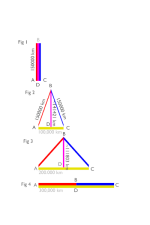Hello all,
I spent some time pondering something I heard Neil Degrasse Tyson say on a video.
Can't remember the video though, I have watched several by him recently.
Anyways, he said that to a photon travel time is instantaneous.
So I made a diagram to help understand what he was saying, using from what I knew about Einstein's mirror setup.
Basically in one second a photon travels 150,000 kilometers in half a second bounces off a mirror and returns traveling 150,000 kilometers more to arrive at the point of origin.
For sake of this argument I am using the value of 300,000 km per second. ( seems close enough for me )
In Fig. 1 The red line is the photon traveling from the origin and the blue line is the return. Line AB and then Line BC
The magenta line is the distance the photon would experience, and that value changes when the origin is moved. Line BD
In the first triangle in my diagram ( fig 2. ) the origin travels left to right 100,000 km in one second ( 1/3 the speed of light ), and the magenta line is the distance the photon experiences.
The distance the photon experiences is less than when the origin is static, since light travels at a constant the time that the photon was moving is less ( total travel time about ~.94 seconds ).
In Fig. 3 the distance the origin travels is 2/3 the speed of light and the reduction in time for the photon is greater and the overall time the photon experiences traveling is ~.74 seconds.
In Fig 4, the origin of the photon moves at the speed of light, and the magenta line has no length so that means the time the photon traveled for zero seconds yet was able to traverse the distance from origin beginning and end ( a cycle of 300,000 km).
I don't know how to say it but for distances less than 300,000 km ( roughly the speed of light ) photons travel instantaneously, maybe for greater distances ( but I have not modeled it so I don't know ).
Strange maybe I got it wrong but that is how I understand it.
Hopefully it isn't too confusing.
I spent some time pondering something I heard Neil Degrasse Tyson say on a video.
Can't remember the video though, I have watched several by him recently.
Anyways, he said that to a photon travel time is instantaneous.
So I made a diagram to help understand what he was saying, using from what I knew about Einstein's mirror setup.
Basically in one second a photon travels 150,000 kilometers in half a second bounces off a mirror and returns traveling 150,000 kilometers more to arrive at the point of origin.
For sake of this argument I am using the value of 300,000 km per second. ( seems close enough for me )
In Fig. 1 The red line is the photon traveling from the origin and the blue line is the return. Line AB and then Line BC
The magenta line is the distance the photon would experience, and that value changes when the origin is moved. Line BD
In the first triangle in my diagram ( fig 2. ) the origin travels left to right 100,000 km in one second ( 1/3 the speed of light ), and the magenta line is the distance the photon experiences.
The distance the photon experiences is less than when the origin is static, since light travels at a constant the time that the photon was moving is less ( total travel time about ~.94 seconds ).
In Fig. 3 the distance the origin travels is 2/3 the speed of light and the reduction in time for the photon is greater and the overall time the photon experiences traveling is ~.74 seconds.
In Fig 4, the origin of the photon moves at the speed of light, and the magenta line has no length so that means the time the photon traveled for zero seconds yet was able to traverse the distance from origin beginning and end ( a cycle of 300,000 km).
I don't know how to say it but for distances less than 300,000 km ( roughly the speed of light ) photons travel instantaneously, maybe for greater distances ( but I have not modeled it so I don't know ).
Strange maybe I got it wrong but that is how I understand it.
Hopefully it isn't too confusing.

